MARKET OVERVIEW
The global solar cell materials market is a unique sector in the renewable energy sector, influenced by the conversion of raw materials into operational parts of solar cell systems. It will remain a vital interface between scientific research and commercial development, shaping how raw substrates and chemical substances become the fundamental building blocks of solar technology. As solar energy continues its applicability across continents, this sector will continue to be central to where electricity will come from in the future.
Solar cell technology is not constrained by one class of compounds. It goes from historic silicon-based models to newer technologies that will continue to build traction in the next few years, such as perovskites and organic polymers. Their function is in the effective collection and conversion of sunlight into usable energy, and this calls for accuracy in design, purity of composition, and reliability in performance. The global solar cell materials market will meet these needs with an emphasis that will reach far beyond existing norms.
This market is not in isolation. It will continue to be connected with manufacturing ecosystems, research centers, and supply chains cutting across regions. Advances in material science will define its path, innovating beyond what solar technologies will be able to provide. Though it seems technical in nature, its reach will extend into everything ranging from energy solutions for homes to the architectural design of urban planning.
What distinguishes the global solar cell materials market is its combination of scientific severity and industrial discipline. Production of materials like monocrystalline silicon wafers or thin-film compounds entails procedures which need to exceed certain stringent benchmarks. They are not simply about efficiency in output but about longevity, ecological suitability, and conformity to changing illumination conditions. The ongoing development of such processes will ensure that the market continues to react to actual needs on the ground, ranging from sites receiving high solar irradiation to areas receiving diffuse sunlight.
In the future, this market will be a proving ground for solutions at scale. Materials that previously existed in research prototypes only will move into big-volume production lines. With that shift, attention won't just be on performance metrics but also on methods of sourcing, recyclability, and minimizing material-related energy consumption. That will change the dialogue from performance at all costs to sustainable integration.
Regulatory systems will dictate the manner in which materials will be created and implemented. The global solar cell materials market will stand at the nexus of policy and science, where standards of quality and compliance will dictate what innovations are advanced into deployment stages. This will necessitate cooperation among governments, industries, and laboratories in order to guarantee that advancement is aligned with overall energy objectives.
Overall, the global solar cell materials market will always be defined by its ability to innovate, adapt, and perform in the face of changing expectations. It will not just be a follower of solar energy but actually set its direction, transforming the building blocks into the drivers of future power systems. Its impact will be structural rather than supportive in altering how energy will be imagined, stored, and utilized.
Global solar cell materials market is estimated to reach $25,456.71 Million by 2032; growing at a CAGR of 7.6% from 2025 to 2032.
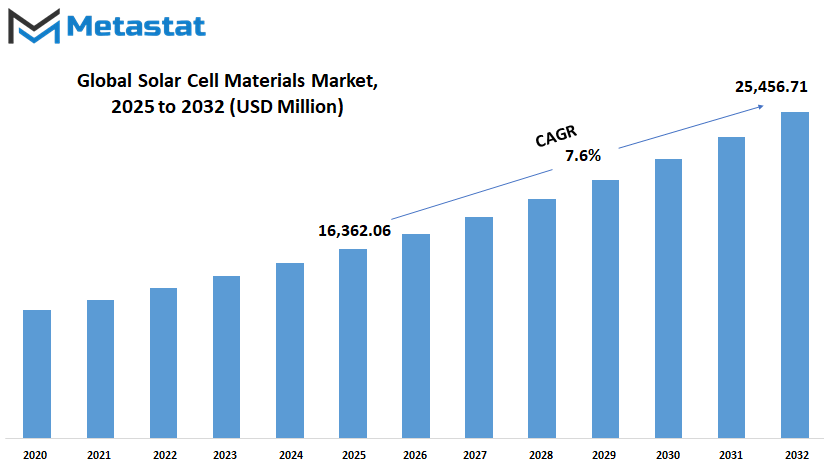
GROWTH FACTORS
The global solar cell materials market will continue to grow steadily as the world shifts towards more sustainable energy sources. This change is driven by rising concerns over climate change and the need to reduce dependence on fossil fuels. People and governments alike are now placing more emphasis on renewable energy, which has opened up fresh demand for solar technology. Among the many parts that make solar power work, the materials used in solar cells play a vital role. These materials directly affect the efficiency and cost of solar panels. As technology advances, so does the quality of these materials, making solar power more reliable and accessible.
One of the key driving factors of the global solar cell materials market is the growing push for cleaner energy policies around the world. Countries are setting ambitious goals for cutting down carbon emissions, and solar power is a leading option to meet these goals. Another major factor is the decrease in the cost of solar panel production, thanks to improvements in material quality and manufacturing methods. These changes make solar panels more affordable for businesses and households, which boosts market growth.
However, certain challenges might slow down this growth. One issue is the availability and cost of raw materials needed for solar cell production. Some of these materials are rare or expensive to extract and process. Another factor that could hamper market growth is the lack of proper infrastructure in some regions, especially where energy needs are high but investment in solar technology is low. Without the right systems in place to support solar power, it's hard to see full market potential in those areas.
Even with these challenges, there are strong reasons to believe the future holds great promise. Continuous research into new materials could change how solar cells are made, possibly leading to higher efficiency and lower prices. Flexible and lightweight materials may soon replace traditional options, allowing solar power to be used in more places and in more creative ways. Government support, through subsidies and tax breaks, would provide lucrative opportunities for the market in coming years. These steps can encourage innovation and make it easier for more people to adopt solar power.
Looking ahead, the global solar cell materials market will likely become even more important as the world looks for long-term energy solutions. Its growth will not only help meet power needs but also support the goal of protecting the environment for future generations.
MARKET SEGMENTATION
By Material Type
The global solar cell materials market is gradually shaping the future of how the world generates and uses energy. As traditional energy sources face limitations, solar power stands out as a cleaner and more sustainable alternative. The materials used in solar cells play a huge role in improving performance and reducing costs. Looking ahead, there is strong potential for new developments and wider adoption. By Material Type, the market is further broken down into Monocrystalline Silicon, Polycrystalline Silicon, Amorphous Silicon, Cadmium Telluride (CdTe), Copper Indium Gallium Selenide (CIGS), Perovskite, and others. Each type comes with its own benefits and challenges, but all are pushing solar technology forward.
Monocrystalline Silicon, known for its high efficiency, is expected to keep leading due to its strong energy output and long lifespan. Although it is more expensive to produce, ongoing research could help bring down costs, making it more accessible to the average user. Polycrystalline Silicon, while slightly less efficient, offers a cheaper option. As improvements are made in production methods, the gap between performance and price may shrink, allowing both types to serve different segments of the market effectively.
Amorphous Silicon is flexible and lightweight, which opens the door for it to be used in more settings, such as on portable devices or curved surfaces. While its efficiency is lower than the others, its adaptability may lead to new applications. CdTe and CIGS materials offer thin-film options that use less material and can be easier to manufacture in large quantities. These options are already used in some large-scale installations and might become even more popular if production becomes cheaper and more efficient.
Perovskite is one of the most talked-about materials in solar research today. It offers high efficiency and can be produced using simpler processes. While there are still challenges, especially in making the material stable over time, the progress in this area is promising. If these issues are solved, Perovskite could become a game-changer in the industry. Other materials are also being studied, especially those that may offer environmental benefits or better performance in specific climates.
In the years ahead, the global solar cell materials market will likely grow because of technological advances and rising global demand for clean energy. New materials and improved methods may bring solar power closer to being a main energy source, helping both everyday users and entire communities move toward more sustainable choices.
By Application
The global solar cell materials market is expected to grow steadily in the coming years as the demand for cleaner and more sustainable energy continues to rise. As more countries commit to cutting down their carbon emissions, solar power will likely become a top priority in energy planning. This shift is pushing the need for more efficient, affordable, and durable solar cell materials. One of the key areas where these materials will be used is in the production of Photovoltaic (PV) modules. These modules are the main components of solar panels, and advancements in materials will improve their ability to convert sunlight into electricity more efficiently. As the technology improves, PV modules will become more accessible and attractive to a wider range of users, from homeowners to businesses.
Another important use of solar cell materials is in Building Integrated Photovoltaics, or BIPV. This involves installing solar panels as part of a building’s structure, like roofs or windows. This approach not only helps generate electricity but also enhances the design and energy efficiency of buildings. In the future, we may see entire neighborhoods built with BIPV systems, making solar energy a natural part of construction rather than an afterthought.
Flexible and wearable solar cells are also gaining attention. These lightweight and bendable materials can be used in items such as outdoor gear, backpacks, or even clothing. As wearable tech continues to grow, these solar cells could offer a way to power devices on the go. With more investment in research and development, these products are expected to become more effective and widely used.
Concentrated Solar Power (CSP) cells are another promising application. Instead of converting sunlight directly into electricity like PV modules, CSP cells use mirrors or lenses to focus sunlight onto a small area to create heat. This heat can then be used to produce electricity, often with thermal storage systems that allow power generation even when the sun isn’t shining. This technology could be especially useful in large-scale energy projects.
Research, testing, and quality assurance will also play a major role in shaping the future of the global solar cell materials market. New prototypes and materials will need to go through rigorous testing to ensure they meet safety and performance standards. As the demand for solar energy rises, so will the need for reliable and consistent solar cell materials, setting the stage for continued growth and innovation across all sectors of this market.
By End User
The global solar cell materials market is expected to grow significantly in the years ahead as demand for clean energy keeps rising. With environmental concerns becoming more urgent and governments supporting sustainable solutions, solar power will become one of the main sources of energy worldwide. The materials used in solar cells will play a major role in this growth, making the market an essential part of the larger energy conversation.
Looking ahead, the market will be shaped by several end users who each have a unique role in pushing solar technology forward. Solar module manufacturers will continue to be key drivers, as they depend on high-quality materials to improve the efficiency and durability of solar panels. Their focus will be on materials that are more affordable and easier to work with, which will help make solar power more accessible in different parts of the world.
R&D institutes and universities will keep playing a major part by researching new ways to improve solar materials. These institutions often lead the way in developing advanced technologies that later get adopted by manufacturers and suppliers. With more funding and attention given to renewable energy research, they will keep experimenting with new materials that could increase power output while reducing costs.
Material suppliers and raw material processors will also be central to this growth. As demand for solar energy expands, these businesses will need to scale up production and improve quality control. Their ability to provide consistent and reliable materials will directly affect the overall success of solar installations.
EPC companies will be responsible for turning designs into working solar farms. Their input helps connect the work of manufacturers and developers, making sure that materials are used properly in real-world settings. They will also influence which materials become standard based on installation needs and performance on the ground.
Solar farm developers, on the other hand, will keep seeking the best materials to lower installation and maintenance costs while improving long-term performance. Their choices will shape future trends, especially as more projects are planned for different climates and terrains.
OEMs will work on integrating solar technology into other products, like homes or vehicles, requiring materials that are flexible and easy to install. Finally, government and regulatory agencies will continue to guide the market through policies and incentives. Their decisions will support research, encourage adoption, and set safety and quality standards.
With all these players working together, the global solar cell materials market will keep moving forward, setting the stage for a future that runs on clean, reliable solar energy.
|
Forecast Period |
2025-2032 |
|
Market Size in 2025 |
$16,362.06 million |
|
Market Size by 2032 |
$25,456.71 Million |
|
Growth Rate from 2025 to 2032 |
7.6% |
|
Base Year |
2024 |
|
Regions Covered |
North America, Europe, Asia-Pacific Green, South America, Middle East & Africa |
REGIONAL ANALYSIS
The global solar cell materials market is shaped by regional differences that reflect both current energy demands and long-term goals for sustainable development. As different parts of the world adapt to climate change and invest in renewable energy, the potential for growth in this market is expanding. North America, with countries like the U.S., Canada, and Mexico, continues to show strong investment in solar technology. In the U.S., government support and increasing awareness of green energy are helping solar materials gain ground, while Canada is focusing on clean energy transitions, and Mexico is working on policies to meet its energy targets.
Europe is also a key area where solar energy is being supported by policy and innovation. The UK, Germany, France, and Italy are each pushing forward with solar initiatives, backed by both government and private sector involvement. These countries are not only using more solar power but are also investing in research to make materials more efficient and affordable. Germany, in particular, is known for its ongoing support of solar energy, helping shape the direction of this market. Meanwhile, other parts of Europe are gradually increasing their investments as well, especially in response to rising energy costs and sustainability commitments.
Asia-Pacific holds the strongest momentum for future growth in this market. Countries like China, India, Japan, and South Korea are making large-scale investments in solar energy, not just for domestic use but also to lead globally in manufacturing and innovation. China is already a global leader in solar panel production, and India is rapidly building new solar infrastructure to reduce its dependency on fossil fuels. Japan and South Korea are continuing to modernize their energy sectors with solar technology at the center of those efforts. This region is expected to shape the future of the global solar cell materials market more than any other.
In South America, countries like Brazil and Argentina are gradually increasing their use of solar energy. Brazil is expanding its solar farms and supporting small-scale solar systems, especially in rural areas. Argentina is also making moves toward adopting more renewable energy sources. These changes, though slower, show promise for long-term development.
The Middle East and Africa are beginning to explore solar options more seriously. Countries like Egypt, South Africa, and the Gulf Cooperation Council nations are starting to invest in solar projects to diversify their energy mix. As solar technology becomes more affordable, these regions are likely to become active players in the global solar cell materials market, helping to support energy access and economic growth.
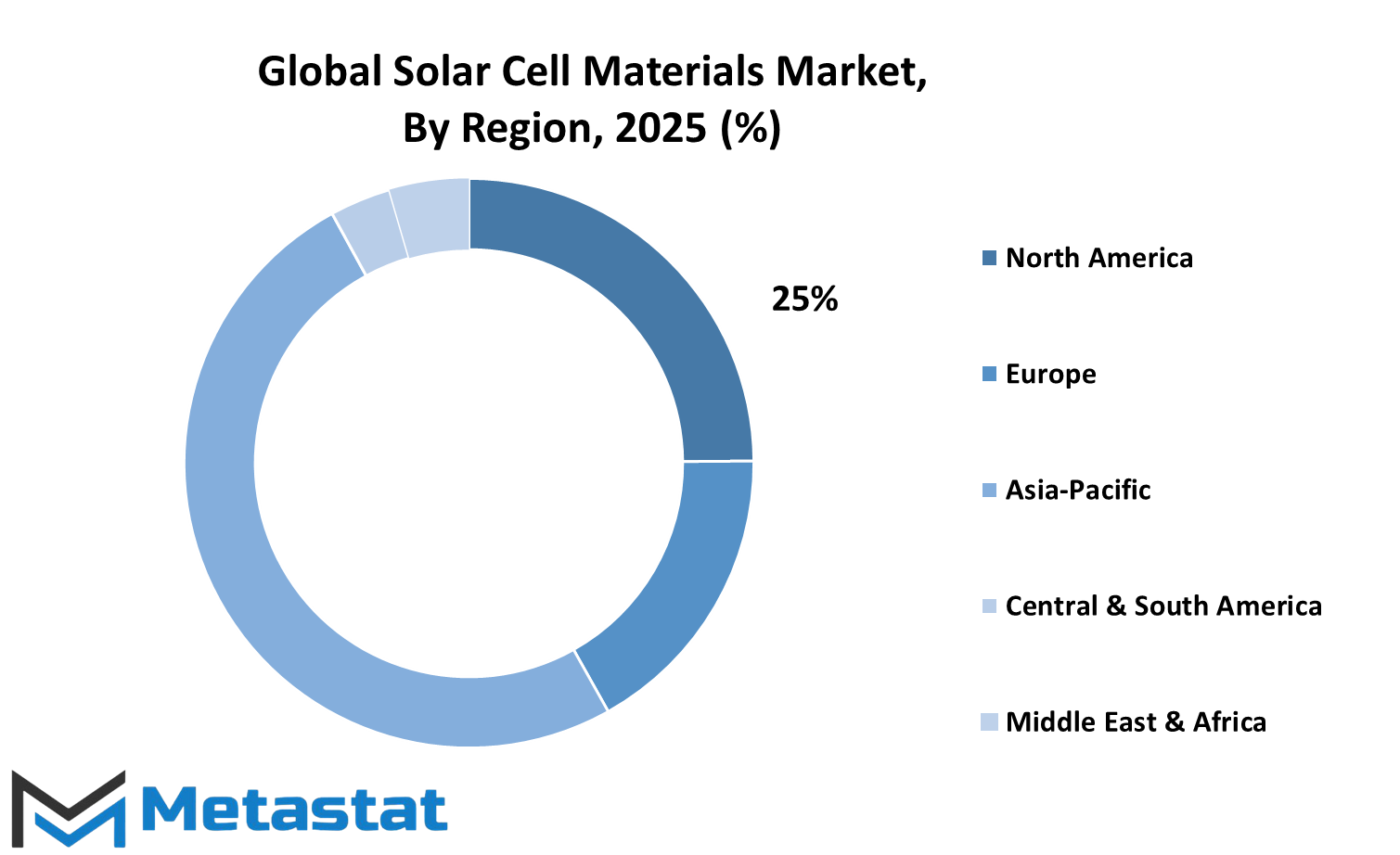
COMPETITIVE PLAYERS
The global solar cell materials market is expected to grow steadily as the world moves toward cleaner and more sustainable sources of energy. As climate concerns become more urgent, governments and industries are focusing on reducing their dependence on fossil fuels. Solar power is one of the most promising alternatives because of its ability to generate electricity without harming the environment. This shift is creating strong demand for high-quality materials used in making solar cells, the key components that convert sunlight into electricity.
Several companies are leading this transition by developing materials that make solar cells more efficient, durable, and affordable. Names such as Wacker Chemie AG, LONGi Green Energy Technology, and Hanwha Solutions are known for their ongoing efforts to improve the quality of silicon and other materials used in solar cell production. These materials affect the performance of solar panels directly, making it essential for manufacturers to keep investing in innovation. Asahi Technologies Inc. and EneCoat Technologies Co., Ltd. are also pushing new boundaries with materials that promise to be lighter and more flexible, which could allow solar panels to be used in more ways than we currently see.
In the coming years, it is likely that the global solar cell materials market will continue to develop smarter and more adaptable solutions. Companies like JA Solar and Adani Solar are working on making solar cells that can still perform well even in low-light conditions, which could help bring solar power to places where it has not been practical before. Targray, Fuji Electric Systems Co., Ltd., and Tokuyama Corporation are also contributing by refining the supply chain and improving the quality and consistency of the materials used in production.
Looking ahead, this market is set to support broader goals related to clean energy, energy security, and economic growth. As more countries set targets to reduce carbon emissions, the demand for solar technology will only grow, creating opportunities for both established companies and newer innovators. The global solar cell materials market will likely become an even more important part of the global energy system. It will play a key role in helping future generations rely more on renewable sources and less on the resources that damage our planet. With ongoing research and support from policy changes, this industry will keep moving forward, shaping a future powered more by sunlight and smart materials.
Solar Cell Materials Market Key Segments:
By Material Type
- Monocrystalline Silicon
- Polycrystalline Silicon
- Amorphous Silicon
- Cadmium Telluride (CdTe)
- Copper Indium Gallium Selenide (CIGS)
- Perovskite
- Other
By Application
- Photovoltaic (PV) Modules Manufacturing
- BIPV (Building Integrated Photovoltaics)
- Flexible & Wearable Solar Cells
- Concentrated Solar Power (CSP) Cells
- R&D/Prototype Development
- Solar Cell Testing and Quality Assurance
By End User
- Solar Module Manufacturers
- R&D Institutes and Universities
- Material Suppliers/Raw Material Processors
- EPC (Engineering, Procurement, and Construction) Companies
- Solar Farm Developers
- OEMs (Original Equipment Manufacturers)
- Government & Regulatory Agencies
Key Global Solar Cell Materials Industry Players
- Wacker Chemie AG
- LONGi Green Energy Technology
- Asahi Technologies Inc.
- EneCoat Technologies Co., Ltd.
- Hanwha Solutions
- JA Solar
- Adani Solar
- Targray
- Tokuyama Corporation
- Fuji Electric Systems Co., Ltd.
WHAT REPORT PROVIDES
- Full in-depth analysis of the parent Industry
- Important changes in market and its dynamics
- Segmentation details of the market
- Former, on-going, and projected market analysis in terms of volume and value
- Assessment of niche industry developments
- Market share analysis
- Key strategies of major players
- Emerging segments and regional growth potential



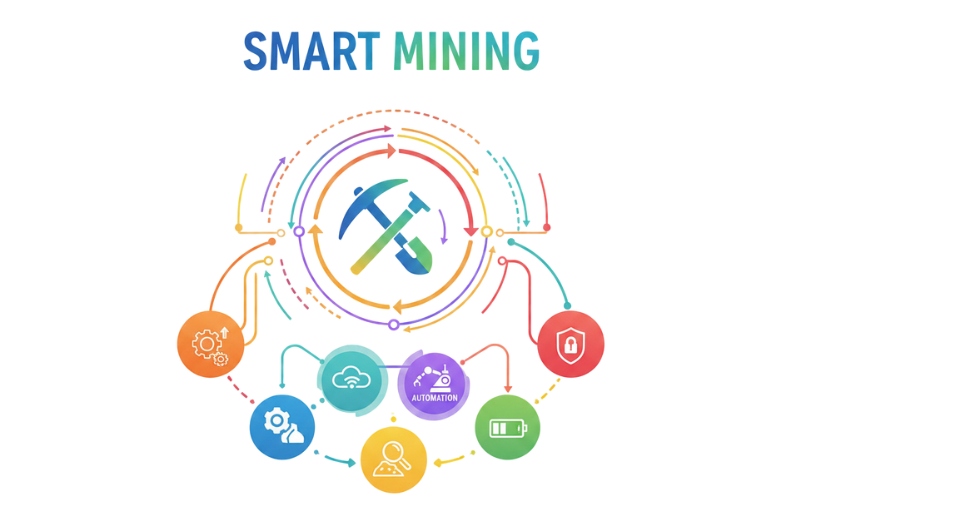
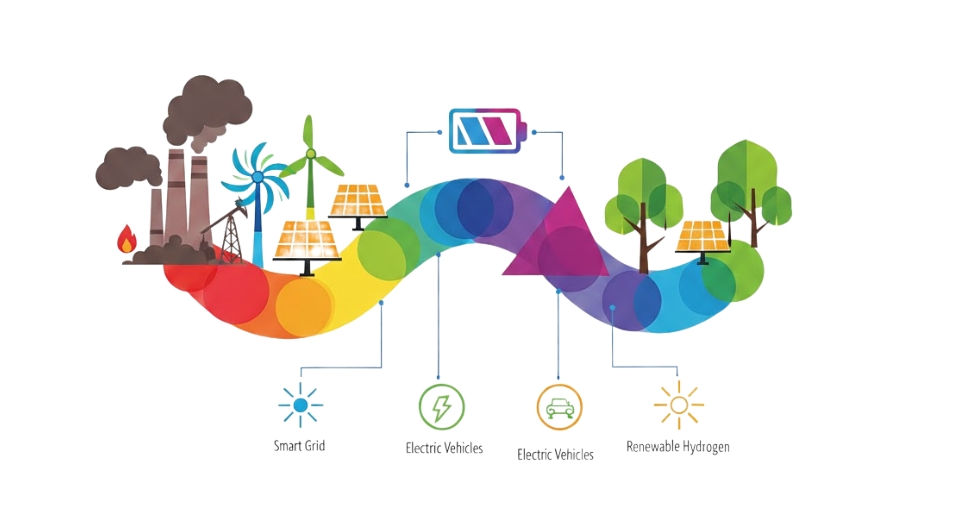

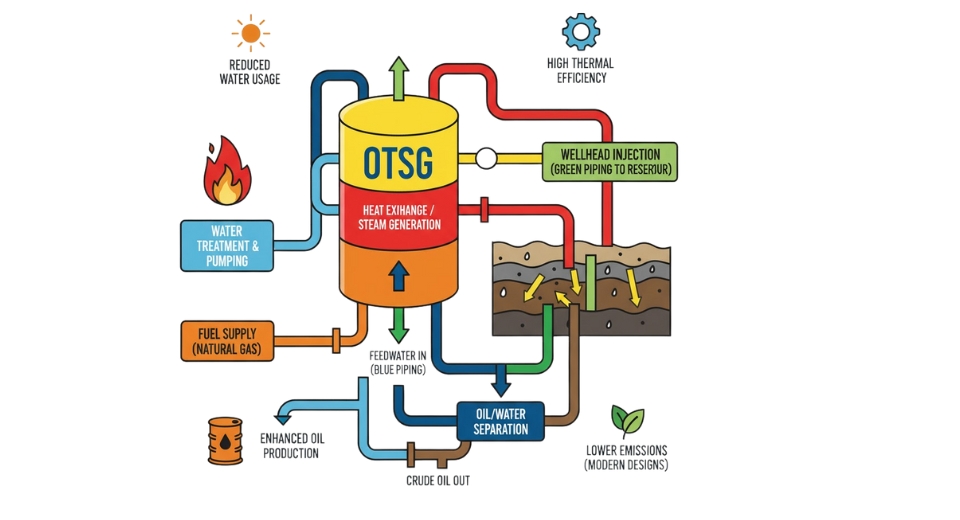

 US: +1-(714)-364-8383
US: +1-(714)-364-8383






